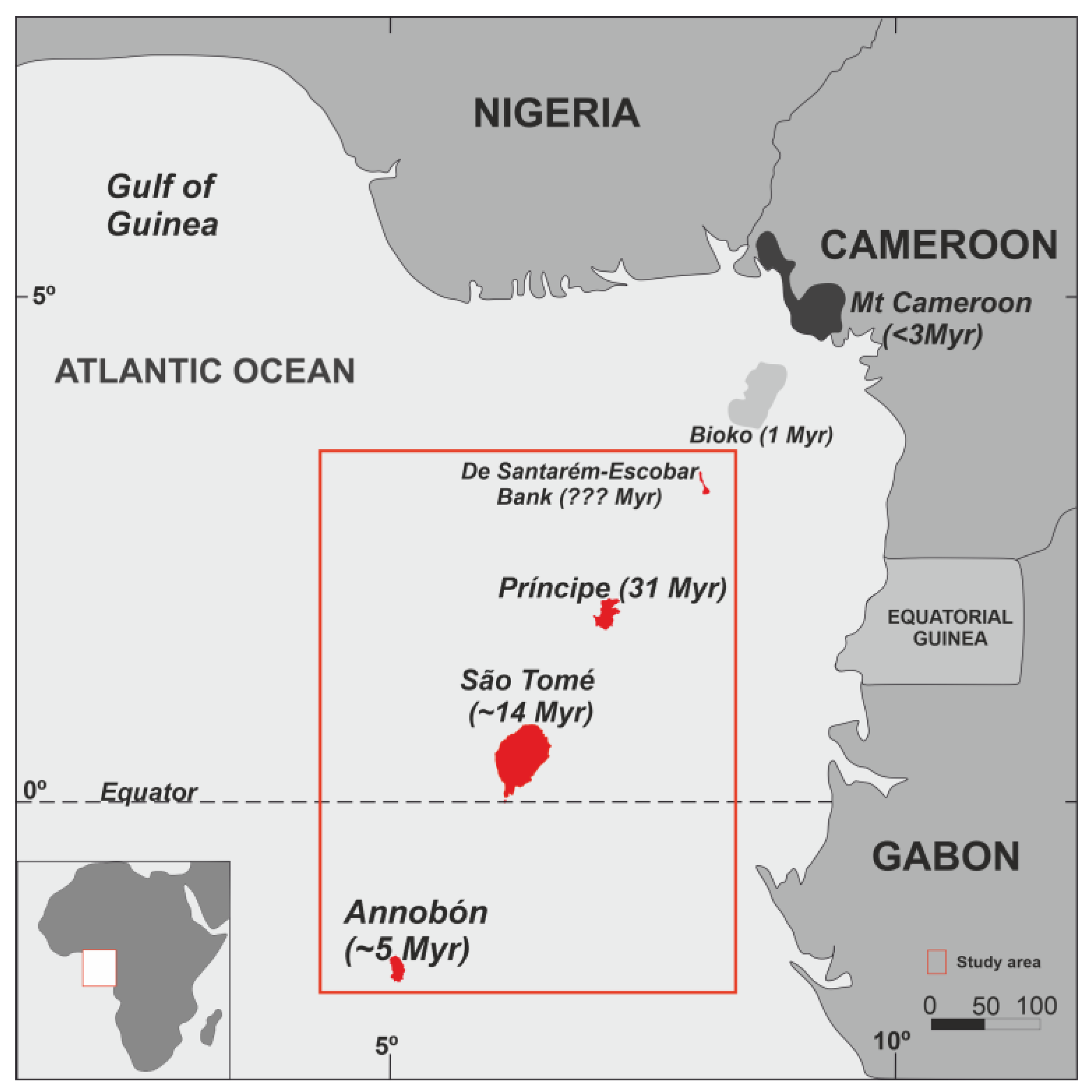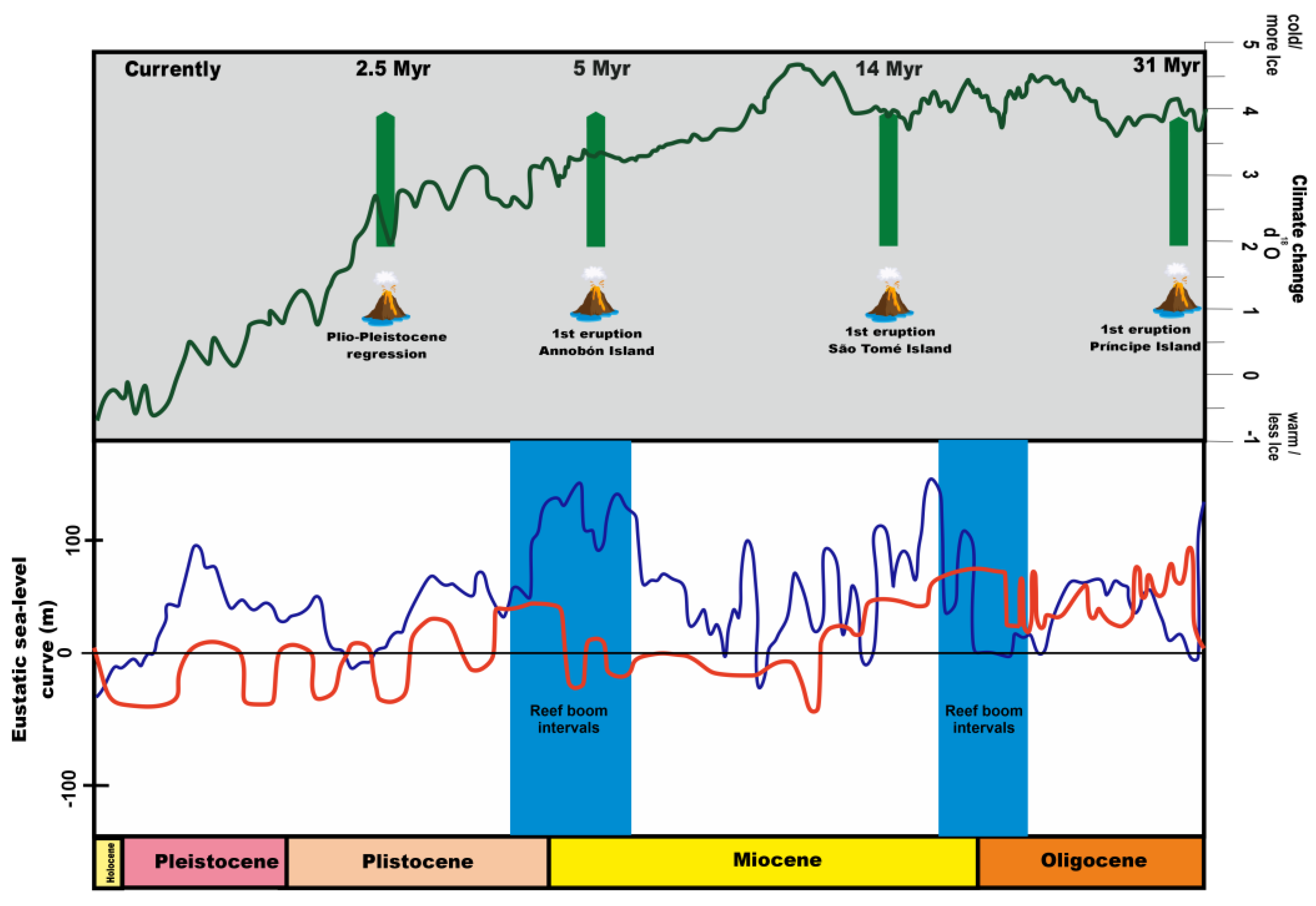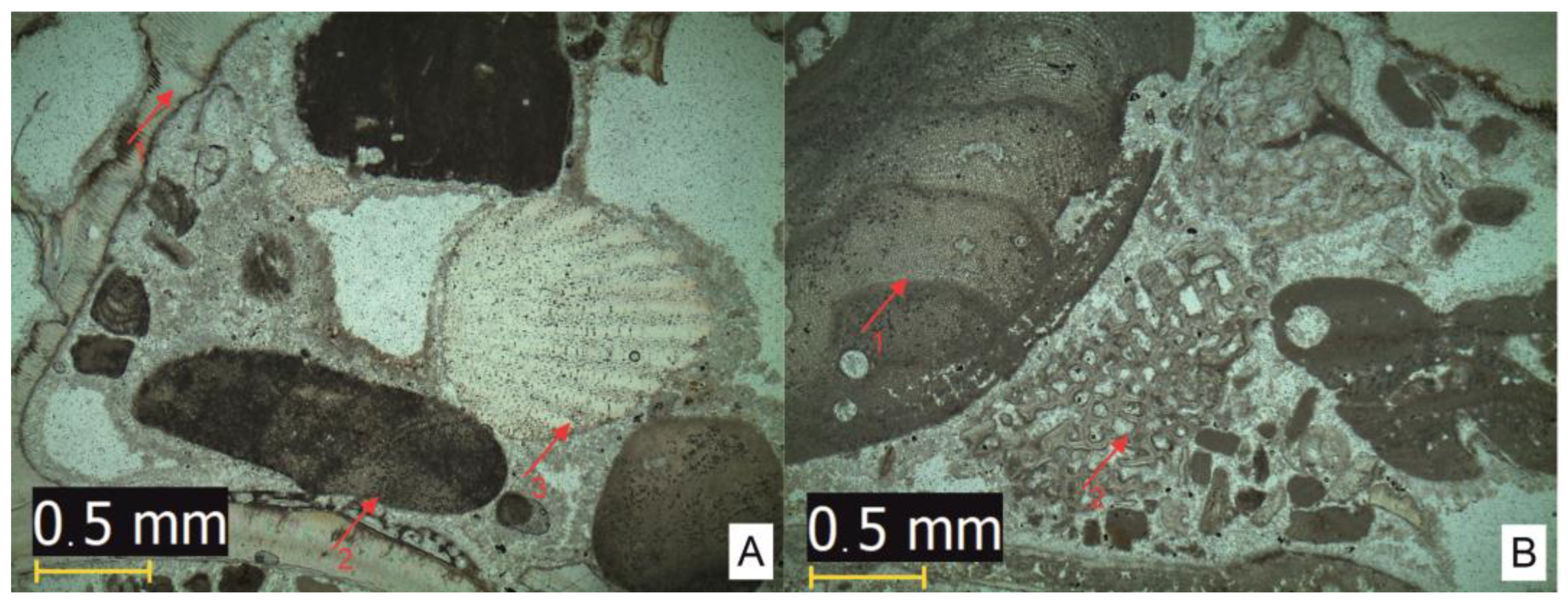A Geo-Itinerary to Foster Sustainable Tourism in West African Islands: Storytelling the Evolution of the Ancient Cameroon Volcanic Line Coral Reefs
Abstract
:1. Introduction
2. Geographical and Geological Setting
3. Materials and Methods
4. Building a Reef Necklace around Darwin’s Theory
4.1. Fringing Coral Reefs: Annobón and São Tomé Islands
4.2. Barrier Coral Reef: Príncipe Island
4.3. The De Santarém–Escobar Seamount
5. Discussion
6. Conclusions
Author Contributions
Funding
Institutional Review Board Statement
Informed Consent Statement
Data Availability Statement
Acknowledgments
Conflicts of Interest
References
- Stoddart, D.R. Darwin, Lyell, and the Geological Significance of Coral Reefs. Brit. J. Hist. Sci. 1975, 9, 199–218. [Google Scholar] [CrossRef]
- Davies, P.J. Antecedent Platforms. In Encyclopedia of Modern Coral Reefs: Structure, Form and Process; Hopley, D., Ed.; Springer: Dordrecht, The Netherlands, 2011; pp. 40–47. [Google Scholar]
- Darwin, C. On certain areas of elevation and subsidence in the Pacific and Indian Oceans, as deduced from the study of coral formations. Proc. Geol. Soc. Lond. 1837, 2, 552–554. [Google Scholar]
- Darwin, C. Journal and Remarks 1832. In Narrative of the Surveying Voyage of His Majesty’s Ships Adventure and Beagle between the Years 1826 and 1836, Describing Their Examination of the Southern shores of South America, and the Beagle’s Circumnavigation of the Globe; Fitzroy, R.N., Ed.; Henry Colburn: London, UK, 1838; Volume III. [Google Scholar]
- Darwin, C.R. The Structure and Distribution of Coral Reefs. Being the First Part of the Geology of the Voyage of the Beagle, Under the Command of Capt. Fitzroy, R.N. During the Years of 1832 to 1836; Smith Elder and Co.: London, UK, 1842. [Google Scholar]
- Rosen, B. Darwin, Coral Reefs, and Global Geology. BioScience 1982, 32, 519–525. [Google Scholar] [CrossRef]
- Daly, R. The glacial-control theory of coral reefs. Proc. Am. Acad. Arts Sci. 1915, 51, 155–251. [Google Scholar] [CrossRef]
- Grigg, R.W.; Grossman, E.E.; Earle, S.A.; Gittings, S.R.; Lott, D.; McDonough, J. Drowned reefs and antecedent karst topography, Au’au Channel, S.E. Hawaiian Islands. Coral Reefs 2002, 21, 73–82. [Google Scholar] [CrossRef]
- Davis, W.M. Coral Reefs and Submarine Banks. J. Geol. 1918, XXVI, 385–411. [Google Scholar] [CrossRef]
- Droxler, A.W.; Jorry, S.J. The Origin of Modern Atolls: Challenging Darwin’s Deeply Ingrained Theory. Annu. Rev. Mar. Sci. 2021, 13, 537–573. [Google Scholar] [CrossRef]
- Raja, N.B.; Pandolfi, J.M.; Kiessling, W. Modularity explains large-scale reef booms in Earth’s history. Facies 2023, 69, 15. [Google Scholar] [CrossRef]
- Laborel, J. West African Reef Corals: A Hypothesis on Their Origin. In Proceedings of the Second International Coral Reef Symposium; Cameron, A.M., Great Barrier Reef Committee, Eds.; Great Barrier Reef Committee: Brisbane, Australia, 1974; Volume 1, pp. 425–443. [Google Scholar]
- Morais, R.A.; Maia, H.A. Lush underwater forests in mesophotic reefs of the Gulf of Guinea. Coral Reefs 2017, 36, 95. [Google Scholar] [CrossRef]
- Berrit, G.R. Les Eaux Dessalées du Golfe de Guinée; Centre De Recherches Oceanographiques: Abidjan, Côte d’Ivoire, 1966; Available online: https://horizon.documentation.ird.fr/exl-doc/pleins_textes/divers15-02/04436.pdf (accessed on 24 October 2023).
- Harris, P.T.; Macmillan-Lawler, M.; Ruppc, J.; Baker, E.K. Geomorphology of the oceans. Mar. Geol. 2014, 352, 4–24. [Google Scholar] [CrossRef]
- Schlager, W. The paradox of drowned reefs and carbonate platforms. GSA Bull. 1981, 92, 197–211. [Google Scholar] [CrossRef]
- Henriques, M.H.; Neto, K. Geoheritage at the Equator: Selected Geosites of São Tomé Island (Cameron Line, Central Africa). Sustainability 2015, 7, 648–667. [Google Scholar] [CrossRef]
- Henriques, M.H.; Neto, K. Revisiting Selected Geosites of São Tomé Island (Cameron Line, Central Africa). In Prime Archives in Sustainability, 1st ed.; Henriques, M.H., Ed.; Vide Leaf: Hyderabad, India, 2019; pp. 1–31. [Google Scholar] [CrossRef]
- Neto, K.; Henriques, M.H. Geoheritage of the Príncipe UNESCO World Biosphere Reserve (West Africa): Selected Geosites. Geoheritage 2023, 15, 118. [Google Scholar] [CrossRef]
- Henriques, M.H. Broadening Frontiers in Geoconservation: The Concept of Intangible Geoheritage Represented by the 1755 Lisbon Earthquake. Geoheritage 2023, 15, 57. [Google Scholar] [CrossRef]
- United Nations. About Small Island Developing States. Available online: https://www.un.org/ohrlls/content/about-small-island-developing-states (accessed on 20 November 2023).
- Pralong, J. Geotourism: A new form of tourism utilising natural landscapes and based on imagination and emotion. Tour. Rev. 2006, 61, 20–25. [Google Scholar] [CrossRef]
- Henriques, M.H.; Pena dos Reis, R. Storytelling the Geoheritage of Viana do Castelo (NW Portugal). Geoheritage 2021, 13, 46. [Google Scholar] [CrossRef]
- Lowery, B.; Dagevos, J.; Chuenpagdee, R.; Vodden, K. Storytelling for sustainable development in rural communities: An alternative approach. Sustain. Dev. 2020, 28, 1813–1826. [Google Scholar] [CrossRef]
- Ruban, D.A. Ancient carbonate reefs as geological heritage: State of knowledge and case example. Carbonates Evaporites 2023, 38, 75. [Google Scholar] [CrossRef]
- Henriques, M.H.; Andrade, A.I.S.; Lopes, F.C. The Earth Sciences among the Community of Portuguese-Speaking countries and the future of Gondwana. Episodes 2013, 36, 255–262. [Google Scholar] [CrossRef]
- Neto, K.; Henriques, M.H. Geoconservation in Africa: State of the art and future challenges. Gondwana Res. 2022, 110, 107–113. [Google Scholar] [CrossRef]
- Burke, K. Origin of the Cameroon Line of volcano-capped swells. J. Geol. 2001, 109, 349–362. [Google Scholar] [CrossRef]
- Adams, A. Insights into the Source of Magmatic Hot-Lines: Forty Years of Geophysical Studies of the Cameroon Volcanic Line. Front. Earth Sci. 2022, 10, 838993. [Google Scholar] [CrossRef]
- Rankenburg, K.; Lassiter, J.C.; Brey, G. The Role of Continental Crust and Lithospheric Mantle in the Genesis of Cameroon Volcanic Line Lavas: Constraints from Isotopic Variations in Lavas and Megacrysts from the Biu and Jos Plateaux. J. Pet. 2005, 46, 169–190. [Google Scholar] [CrossRef]
- Tefogoum, G.Z.; Nkouathio, D.G.; Dongmo, A.K.; Dedzo, M.G. Typology of geotouristic assets along the south continental branch of the Cameroon volcanic line: Case of the mount Bambouto’s caldera. Intern. J. Geoh Parks 2019, 7, 111–128. [Google Scholar] [CrossRef]
- Toteu, S.F.; Anderson, J.M.; de Wit, M. “Africa Alive Corridors”: Forging a new future for the people of Africa by the people of Africa. J. Afr. Earth Sci. 2010, 58, 692–715. [Google Scholar] [CrossRef]
- CPLP. Processo Histórico. Comunidade dos Países de Língua Oficial Portuguesa. Available online: https://www.cplp.org/id-2752.aspx (accessed on 19 October 2023).
- De Wit, M.J.; Anderson, J.M. Gondwana Alive Corridors: Extending Gondwana Research to Incorporate Stemming the Sixth Extinction. Gondwana Res. 2003, 6, 369–408. [Google Scholar] [CrossRef]
- Kleypas, J.A. Coral reef development under naturally turbid conditions: Fringing reefs near Broad Sound, Australia. Coral Reefs 1996, 15, 153–167. [Google Scholar] [CrossRef]
- Veron, J.E.N.; Stafford-Smith, M.G.; Turak, E.; DeVantier, L.M. Corals of the World. 2016. Available online: http://www.coralsoftheworld.org/coral_geographic/interactive_map/results/ (accessed on 22 October 2023).
- Spalding, M.D.; Ravilious, C.; Green, E.P. World Atlas of Coral Reefs, 1st ed.; University of California Press: Berkeley, CA, USA, 2001. [Google Scholar]
- Lee, D.-C.; Halliday, A.N.; Fitton, J.G.; Poli, G. Isotopic variations with distance and time in the volcanic islands of the Cameroon line: Evidence for a mantle plume origin. Earth Planet Sc Lett. 1994, 123, 119–138. [Google Scholar] [CrossRef]
- Njonfang, E.; Nono, A.; Kamgang, P.; Ngak, V.; Tchoua, F.M. Cameroon Line alkaline magmatism (Central Africa): A reappraisal. Geol. Soc. Am. Spec. Paper 2011, 478, 173–191. [Google Scholar] [CrossRef]
- Crosby, A.G.; McKenzie, D. An analysis of young ocean depth, gravity and global residual topography. Geophys. J. Int. 2009, 178, 1198–1219. [Google Scholar] [CrossRef]
- Zachos, J.C.; Dickens, G.R.; Zeebe, R.E. An early Cenozoic perspective on greenhouse warming and carbon-cycle dynamics. Nature 2008, 451, 279–283. [Google Scholar] [CrossRef] [PubMed]
- Wright, J.D. Cenozoic Climate Change. In Encyclopedia of Paleoclimatology and Ancient Environments; Gornitz, V., Ed.; Springer: Dordrecht, The Netherlands, 2009; pp. 148–155. [Google Scholar] [CrossRef]
- Mathew, M.; Makhankova, A.; Menier, D.; Sautter, B.; Betzler, C.; Pierson, B. The emergence of Miocene reefs in South China Sea and its resilient adaptability under varying eustatic, climatic and oceanographic conditions. Sci. Rep. 2020, 10, 7141. [Google Scholar] [CrossRef] [PubMed]
- Glischler, E. Quaternary reef response to sea-level and environmental change in the western Atlantic. Sedimentology 2015, 62, 429–465. [Google Scholar] [CrossRef]
- Németh, K. Volcanic Geoheritage in the Light of Volcano Geology. In El Hierro Island Global Geopark. Geoheritage, Geoparks and Geotourism; Dóniz-Páez, J., Pérez, N.M., Eds.; Springer: Cham, Switzerland, 2022; pp. 1–24. [Google Scholar] [CrossRef]
- Pena dos Reis, R.; Henriques, M.H. Approaching an integrated qualification and evaluation system for geological heritage. Geoheritage 2009, 1, 1–10. [Google Scholar] [CrossRef]
- Henriques, M.H.; Pena dos Reis, R.; Garcia, G.G.; João, P.; Marques, R.M.; Custódio, S. Developing paleogeographic heritage concepts and ideas through the Upper Jurassic record of the Salgado and Consolação geosites (Lusitanian Basin, Portugal). Resour. Policy 2022, 76, 102594. [Google Scholar] [CrossRef]
- Grigg, R.W. Paleoceanography of coral reefs in the Hawaiian-Emperor Chain—Revisited. Coral Reefs 1997, 16, S33–S38. [Google Scholar] [CrossRef]
- M.M.U. Carta Hidrográfica da Ilha de S. Tomé. Ministério da Marinha e do Ultramar: Lisboa, Portugal. 1963. Available online: https://gpixel.org/q/m/sth/yndex.php#zoom=1.2222405&x=0.5751106&y=0.4618568 (accessed on 14 October 2023).
- M.M.U. Carta Hidrográfica da Ilha do Príncipe. Ministério da Marinha e do Ultramar: Lisboa, Portugal. Available online: https://gpixel.org/q/m/pch/yndex.php#zoom=1.887791&x=0.2370025&y=0.1588588 (accessed on 14 October 2023).
- GEBCO Compilation Group. Global Ocean & Land Terrain Models. GEBCO_2023 Grid. Available online: https://www.gebco.net/data_and_products/gridded_bathymetry_data/gebco_2023/ (accessed on 22 October 2023).
- Kelley, D.; Page, K.; Quiroga, D.; Salazar, R. The Geodiversity and Geoheritage of the Galapagos Islands: A Geotouristic Guide. In the Footsteps of Darwin: Geoheritage, Geotourism and Conservation in the Galapagos Islands; Kelley, D., Page, K., Quiroga, D., Salazar, R., Eds.; Springer: Cham, Switzerland, 2019; pp. 135–183. [Google Scholar]
- Martínez-Frías, J.; Mogessie, A. The need for a geoscience education roadmap for Africa. Episodes 2012, 35, 489–492. [Google Scholar] [CrossRef] [PubMed]
- Errami, E.; Schneider, G.; Ennih, N.; Randrianaly, H.N.; Bendaoud, A.; Noubhani, A.; Norman, N.; Allan, M.; Lopo Vasconcelos, L.C.; Al-Wosabi, M.; et al. Geoheritage and Geoparks in Africa and the Middle-East: Challenges and Perspectives. In From Geoheritage to Geoparks. Geoheritage. Geoparks and Geotourism; Errami, E., Brocx, M., Semeniuk, V., Eds.; Springer: Cham, Switzerland, 2015; pp. 3–23. [Google Scholar] [CrossRef]
- Corda, L.; Palmiotto, C. Rhodalgal–foramol facies in equatorial carbonates: Insights from Miocene tectonic islands of the central Atlantic. Palaeogeogr. Palaeoclimatol. Palaeoecol. 2015, 428, 21–30. [Google Scholar] [CrossRef]
- Haq, B.U.; Hardenbol, J.; Vail, P.R. Chronology of fluctuating sea levels since the Triassic (250 million years ago to present). Science 1987, 235, 1156–1167. [Google Scholar] [CrossRef]
- Miller, K.G.; Browning, J.V.; Schmelz, W.J.; Kopp, R.E.; Mountain, G.S.; Wright, J.D. Cenozoic sea-level and cryospheric evolution from deep-sea geochemical and continental margin records. Sci. Adv. 2020, 6, eaaz1346. [Google Scholar] [CrossRef]
- Gradstein, F.M.; Ogg, J.G.; Schmitz, M.; Ogg, G. Geologic Time Scale 2020, 1st ed.; Elsevier: Amsterdam, The Netherlands, 2020. [Google Scholar]
- DPOA. Annobón. Equatorial Guinea. Digital Observatory for Protected Areas (DOPA) Explorer. European Commission. Available online: https://dopa-explorer.jrc.ec.europa.eu/wdpa/20269 (accessed on 11 October 2023).
- Cornen, G.; Maury, R.C. Petrology of the volcanic island of Annobon, Gulf of Guinea. Mar. Geol. 1980, 36, 253–267. [Google Scholar] [CrossRef]
- Almeida, A.; Ribeiro, S.; Botelho, H. Parque Nacional Obô: Conhecimento e perceções acerca da sua importância em alunos de S. Tomé. AmbientalMENTEsustenTable 2017, 1, 223–232. [Google Scholar] [CrossRef]
- TSTP. Parques Naturais. Turismo de São Tomé e Príncipe. Available online: https://visitsaotomeprincipe.st/en/lugares/regiao-centro-de-sao-tome/parques-naturais (accessed on 18 October 2023).
- Caldeira, R.; Munhá, J.M. Petrology of ultramafic nodules from São Tomé Island, Cameroon Volcanic Line (oceanic sector). J. Afr. Earth Sci. 2002, 34, 231–246. [Google Scholar] [CrossRef]
- Caldeira, R.; Madeira, J.; Munhá, J.M.; Afonso, R.S.; Mata, J.; Tassinari, C.C.; Nascimento, E. Caracterização das principais unidades volcano-estratigráficas da ilha de São Tomé, Golfo da Guiné. Ciências Terra 2003, V, A15–A18. Available online: https://repositorio.lneg.pt/bitstream/10400.9/946/1/28627CD_A15.pdf (accessed on 25 October 2023).
- Roik, A.; Order, C.; Röthig, T.; Voolstra, C.R. Spatial and seasonal reef calcification in corals and calcareous crusts in the central Red Sea. Coral Reefs 2016, 35, 681–693. [Google Scholar] [CrossRef]
- Weiss, A. Crustose coralline algae increased framework and diversity on ancient coral reefs. PLoS ONE 2017, 12, e0181637. [Google Scholar] [CrossRef] [PubMed]
- Teichert, S.; Steinbauer, M.; Kiessling, W. A possible link between coral reef success, crustose coralline algae and the evolution of herbivory. Sci. Rep. 2020, 10, 17748. [Google Scholar] [CrossRef]
- Lopes, J.M.R. Geocronologia Ar-Ar e Geoquímica Isotópica de Rochas das Ilhas de Ano-Bom, São Tomé e Príncipe da Linha Vulcânica dos Camarões. Ph.D. Thesis, Universidade de São Paulo, São Paulo, Brazil, 2020. Available online: https://www.teses.usp.br/teses/disponiveis/44/44141/tde-19112020-094211/publico/Dissertacao_Jose_Manuel_Ramos_Lopes.pdf (accessed on 11 October 2023).
- Dunlop, H.M.; Fitton, J.G. A K-Ar and Sr-isotopic study of the volcanic rocks of the island of principe, West Africa—Evidence for mantle heterogeneity beneath the Gulf of Guinea. Contrib. Miner. Petr 1979, 7, 125–131. [Google Scholar] [CrossRef]
- UNESCO. Island of Principe Biosphere Reserve, Sao Tome and Principe. Available online: https://en.unesco.org/biosphere/africa/island-of-principe (accessed on 26 October 2023).
- De Esteban, M.C.; Haroun, R.; Tuya, F.; Abreu, A.D.; Otero-Ferrer, F. Mapping marine habitats in the Gulf of Guinea: A contribution to the future establishment of Marine Protected Areas in Principe Island. Reg. Stud. Mar. Sci. 2023, 57, 102742. [Google Scholar] [CrossRef]
- Silva, G.H. La Faune Miocène de l’Île du Prince. Memórias Notícias 1956, 42, 29–52. [Google Scholar]
- Pérez-Díaz, L.; Eagles, G. South Atlantic paleobathymetry since early Cretaceous. Sci. Rep. 2017, 7, 11819. [Google Scholar] [CrossRef]
- Henriques, M.H.; Pena dos Reis, R.; Brilha, J.; Mota, T. Geoconservation as an Emerging Geoscience. Geoheritage 2011, 3, 117–128. [Google Scholar] [CrossRef]
- Brilha, J. Inventories and Evaluation. In Geoheritage; Reynard, E., Brilha, J., Eds.; Elsevier: Chennai, India, 2016; pp. 67–86. [Google Scholar]
- Johnson, M.E.; Baarli, B.G.; Cachão, M.; Mayoralc, E.; Ramalho, R.S.; Santos, A.; da Silva, C.M. On the rise and fall of oceanic islands: Towards a global theory following the pioneering studies of Charles Darwin and James Dwight Dana. Earth Sci. Rev. 2018, 180, 17–36. [Google Scholar] [CrossRef]
- Frodeman, R. Geology and Knowledge Culture. In Bridges to Global Ethics. Geoethics at the Confluence of Humanities and Sciences; Di Capua, G., Oosterbeek, L., Eds.; Springer: Cham, Switzerland, 2023; pp. 41–53. [Google Scholar] [CrossRef]
- Fitton, J.G.; Dunlop, H.M. The Cameroon Line, West-Africa, and Its Bearing on the Origin of Oceanic and Continental Alkali Basalt. Earth Planet. Sci. Lett. 1985, 72, 23–38. [Google Scholar] [CrossRef]
- Henriques, M.H.; Pena dos Reis, R. Framing the Palaeontological Heritage within the Geological Heritage: An Integrative Vision. Geoheritage 2015, 7, 249–259. [Google Scholar] [CrossRef]
- Carvalho, I.S.; Raminelli, R.; Henriques, M.H.P.; Soares, R.C.; Andrade, J.A.F.G.; Freitas, F.I. The Araripe Geopark (NE Brazil): Discovering the Earth’s Past as a Driver of Economic and Social Transformation. Geoheritage 2021, 13, 60. [Google Scholar] [CrossRef]
- UNDP. Human Development Report the Next Frontier. Human Development and the Anthropocene. UNDP: New York, USA. Available online: http://hdr.undp.org/sites/default/files/hdr2020.pdf#page=357 (accessed on 28 October 2023).







| Organization | Reference | Access |
|---|---|---|
| GEBCO Compilation Group (2023) | The GEBCO_2023 Grid [51] | https://www.gebco.net/data_and_products/gridded_bathymetry_data/gebco_2023/ (accessed on 11 December 2023) |
| Ministério da Marinha e do Ultramar (1965) | Carta Hidrográfica da Ilha do Príncipe [50] | https://gpixel.org/q/m/pch/yndex.php#zoom=1.887791&x=0.2370025&y=0.1588588 (accessed on 11 December 2023) |
| Ministério da Marinha e do Ultramar (1963–1964) | Carta Hidrográfica da Ilha de S. Tomé [49] | https://gpixel.org/q/m/sth/yndex.php#zoom=1.2222405&x=0.5751106&y=0.4618568 (accessed on 11 December 2023) |
Disclaimer/Publisher’s Note: The statements, opinions and data contained in all publications are solely those of the individual author(s) and contributor(s) and not of MDPI and/or the editor(s). MDPI and/or the editor(s) disclaim responsibility for any injury to people or property resulting from any ideas, methods, instructions or products referred to in the content. |
© 2023 by the authors. Licensee MDPI, Basel, Switzerland. This article is an open access article distributed under the terms and conditions of the Creative Commons Attribution (CC BY) license (https://creativecommons.org/licenses/by/4.0/).
Share and Cite
Henriques, M.H.; Neto, K. A Geo-Itinerary to Foster Sustainable Tourism in West African Islands: Storytelling the Evolution of the Ancient Cameroon Volcanic Line Coral Reefs. Sustainability 2023, 15, 16863. https://doi.org/10.3390/su152416863
Henriques MH, Neto K. A Geo-Itinerary to Foster Sustainable Tourism in West African Islands: Storytelling the Evolution of the Ancient Cameroon Volcanic Line Coral Reefs. Sustainability. 2023; 15(24):16863. https://doi.org/10.3390/su152416863
Chicago/Turabian StyleHenriques, Maria Helena, and Keynesménio Neto. 2023. "A Geo-Itinerary to Foster Sustainable Tourism in West African Islands: Storytelling the Evolution of the Ancient Cameroon Volcanic Line Coral Reefs" Sustainability 15, no. 24: 16863. https://doi.org/10.3390/su152416863
APA StyleHenriques, M. H., & Neto, K. (2023). A Geo-Itinerary to Foster Sustainable Tourism in West African Islands: Storytelling the Evolution of the Ancient Cameroon Volcanic Line Coral Reefs. Sustainability, 15(24), 16863. https://doi.org/10.3390/su152416863







